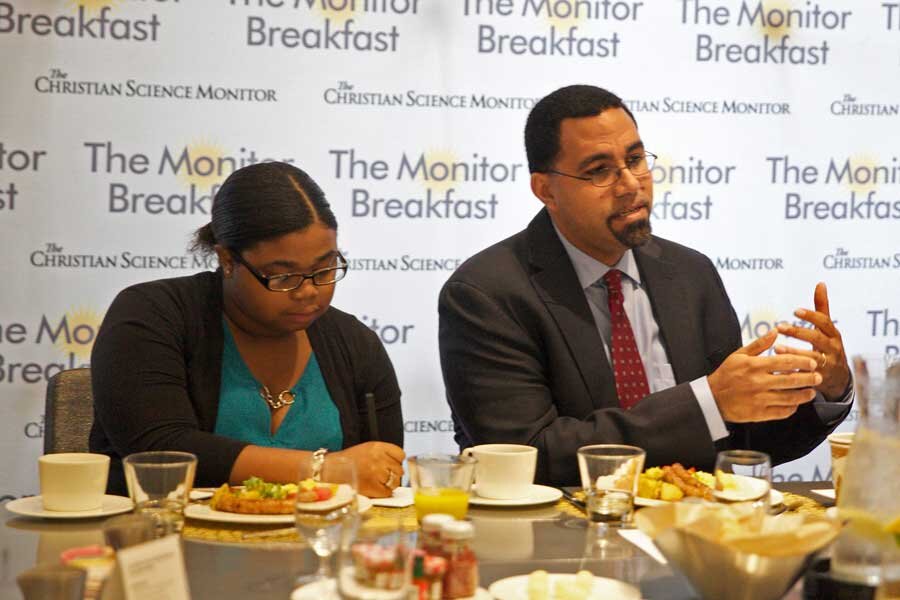Education Secretary John King: US still has work to do on equity in schools
Loading...
| Washington
The walls of a prison have a way of giving people new perspective on opportunity.
That held true for Secretary of Education John King Jr., on a recent visit to Limestone Correctional Facility in Harvest, Ala., where he talked with inmates during his “Opportunity Across America” tour last week.
“I was struck by how clear they are about the role of education, both in how they got to where they are and in how it will make their lives better when they get back,” Secretary King said Wednesday morning at a breakfast for reporters hosted by the Monitor in Washington.
The inmates take part in education and training in a choice of 11 fields that offer good job prospects – from welding to horticulture to mechanical design – through a partnership with Calhoun Community College. The site is part of a nationwide Second Chance Pell Pilot Program, in which inmates eligible for release within five years can receive federal grants to pursue post-secondary education.
More broadly, the tour focused on three key areas in which the US Department of Education has been pushing for progress, King said: “Equity and excellence throughout our educational system; lifting up the teaching profession; and access, affordability and completion in higher ed.”
Despite dramatic progress in high school graduation rates and the number of African-American and Hispanic students going on to college, King noted that achievement gaps are still large. While there’s no silver bullet, he said, “there are places that are getting real benefits from an intentional diversity strategy” that mixes students from different socioeconomic backgrounds.
President Obama has proposed $120 million to support local voluntary efforts to boost racial and socioeconomic diversity in schools. This summer, the Stronger Together Diversity Act was introduced in both the House and Senate.
No large urban school district can yet say “they are getting phenomenal outcomes compared with affluent suburban communities,” King noted. But there are many making good strides.
In Long Beach, Calif., for instance, graduation and college attendance rates have climbed steadily with strategies such as dual enrollment in high school and community college, he said.
Another gap that’s often less discussed is the neglect that talented minority and low-income students often face – such as lack of access to Advanced Placement and International Baccalaureate programs. The Education Department offers grants to boost such access because research has shown that high school students who participate in classes that offer college-level work are more likely to graduate and go on to college, King said.
Recent efforts have also focused on helping schools focus beyond academics to students’ social-emotional development. A growing body of research is available can guide schools in “how you help students build not just resilience, but a sense of hope about their future,” King said.
The Department of Education and the White House hosted a conference Monday about trauma-informed practices and school discipline issues specifically focused on the needs of girls of color.
On the higher-education front, issues of affordability, student debt, and for-profit college closures have been making headlines. But while the nation has long talked about access and affordability to college, King said, there has not been “enough conversation about the completion challenge…. You’re dramatically more likely to default [on student loans] if you didn’t finish your degree.”
His tour included a stop at Louisiana State University in Baton Rouge, which has shown progress in student completion rates.
But the continued lack of socioeconomic diversity in the nation’s top colleges, King said, prompts the question: “What is the moral responsibility of the most selective colleges?”
He cited Vassar College in Poughkeepsie, N.Y., and Franklin & Marshall College in Lancaster, Pa., as leaders in broadening their student bodies, and says they approach it as “ultimately… a talent strategy – that their student body is stronger as a result of their recruitment effort around low income students and students of color.”
On the issue of school funding and equity, the Department has been criticized by Republican lawmakers for draft rules to implement a provision in the Every Student Succeeds Act known as “supplement not supplant.” It is intended to ensure that states use federal dollars as additional resources for low-income students rather than cut back on state money and fill in the gaps with the federal money. The rules have been criticized by Sen. Lamar Alexander (R) of Tennessee, the chairman of the Senate education committee, which said it could turn state and local funding structures upside down. The rules also have come in for criticism by some typical Democratic allies, such as teachers’ unions.
But on Wednesday, King stood firm on his position that the rules are consistent with the law as written. “It is hard to reconcile an affluent school getting 25 to 30 percent more dollars than a school serving poor students 10 blocks away with the words, ‘supplement not supplant,’ ” he said.






